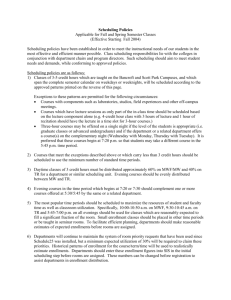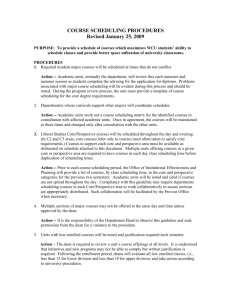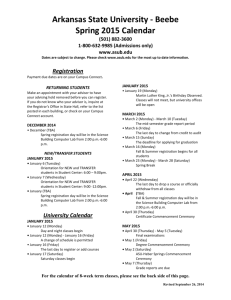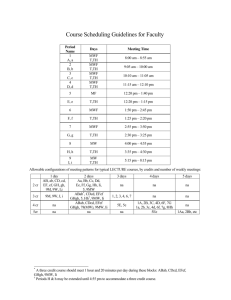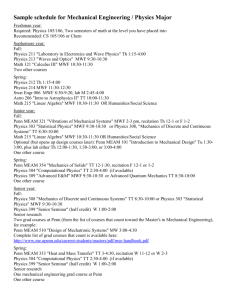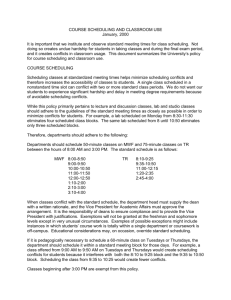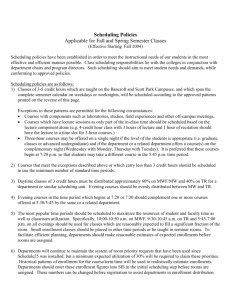University Scheduling Grid
advertisement
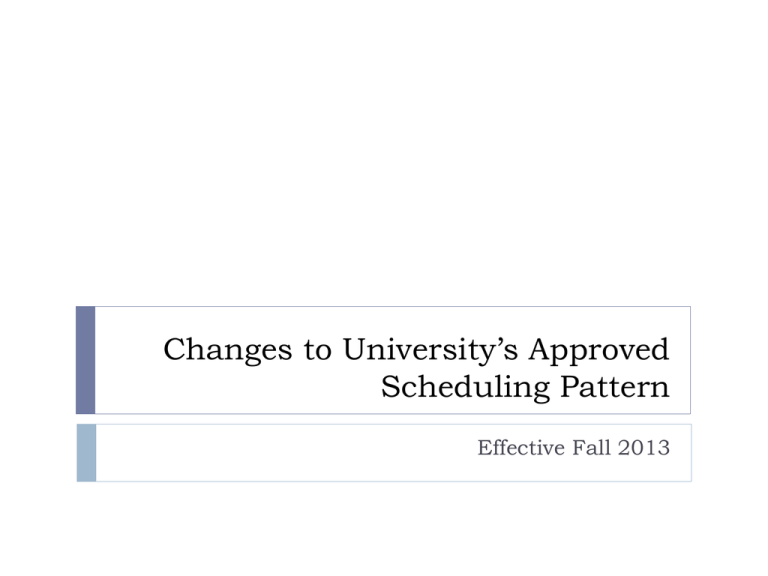
Changes to University’s Approved Scheduling Pattern Effective Fall 2013 Updated structure provides more flexibility and improves space utilization Benefits of this new scheduling structure: Provides more flexibility to all schools/departments, especially those whose course materials are best presented in longer 75minute class sessions. Helps distribute courses among peak and non-peak times. Enhances classroom utilization and limits conflicts by nesting 50 minute offerings in the 75 minute meeting pattern. University Scheduling Structure, effective Fall 13 Time periods: Monday-Friday (note the ‘nesting’ of 50-minute courses within 75-minute courses) Period 75 Minute Classes 50 Minute Classes 150 Minute Classes 1* 8:10-9:25 8:10-9:00 8:10 – 10:40 2 9:40-10:55 9:40-10:30 3 11:10-12:25 11:10 – 12:00 11:10 – 1:40 4 12:40-1:55 12:40 – 1:30 12:40 – 3:10 5 2:10-3:25 2:10-3:00 2:10 – 4:40 6 3:40-4:55 3:40-4:30 3:40 – 6:10 7 5:10-6:25 5:10-6:00 5:10 – 7:40 8** 6:40-7:55 6:40-7:30 6:40 – 9:10 FYE Classes MWF 9:10 am & 10:10 am 9:40 – 12:10 *Classes can start anytime before or within period one as long as they end by 9:30 am. **There is no conforming time requirement for classes starting after 7:30 pm. Prime Times are periods 3-5 Old scheduling pattern no longer applicable effective fall 13 Classes meeting on Mondays, Wednesdays, and/or Fridays must begin at: 8:10 am 9:10 am 10:10 am 11:10 am 12:10 pm 1:10 pm 2:10 pm 3:10 pm 4:10 pm 5:10 pm 6:10 pm 7:10 pm 8:10 pm 9:10 pm Classes meeting on Tuesdays and/or Thursdays must begin at: 8:10 am 9:35 am 11:10 am 12:35 pm 2:10 pm 3:35 pm 5:10 pm 6:35 pm 8:10 pm 9:35 pm Meeting patterns: Monday/Wednesday/Friday- for 50-minutes classes that meet three times a week Monday/Wednesday, Wednesday/Friday, Monday/Friday and Tuesday/Thursday- for 75-minute classes that meet two times per week One day per week classes may be scheduled on any day of the week at the 150 minute class times. Notes: courses that meet for 50 minutes, three times a week must meet on MWF. Unfortunately allowing any other three-day combinations would lead to extensive complications in student schedules. Distribution Constraints: Constraints are applied to all classes that have a meeting pattern. The constraints are applied to courses that meet in department spaces. Independent studies and courses without meeting patterns won’t be counted. Off-Campus courses are not counted, and the above schedule does not apply. Departments may schedule UP TO 50% of all their classes during periods 3-5 (prime time). Classes that span multiple periods will be counted multiple times. Departments may schedule UP TO 50% of their courses in the T/TH meeting pattern. Of the classes offered two days per week on any combination of MWF, departments can only have up to 50% offered on MW. Departments must balance MW offerings with an equal number of MF and/or WF offerings. Once-per-week classes must start according to the 150-minute meeting blocks. If the once-per-week class starts prior to period 7 it must be paired in a two-day per week meeting pattern (MW, WF, TR) indicated above. For example, a M class starting in period 2 must be balanced with another W class starting in the same period. This matching provision does not apply to classes offered on Friday, beginning with period 6 and later. Additional clarifications: Classes can start anytime before or within period one as long as they end by 9:30 am. There is no conforming time requirement for classes starting after 7:30 pm FYE sections will continue to meet at the 9:10 and 10:10 time on MWF. Clarifications The approved scheduling pattern and associated constraints do not apply to summer courses. Courses that meet in department controlled space are expected to comply with the university scheduling grid and to the scheduling constraints. Classes that don’t comply with the university scheduling policy and the constraints will not receive room assignments and will be hidden from the course offerings. How it’s working so far… We are just about finished with the fall 2013 rooming process, which give us our first indications of the effects of the new grid. Overall we had far less classes that we couldn’t room. Typically there are about 30-40 classes that want certain meeting times that are over full. For fall 13 we had approximately 10 classes that we couldn’t room. (MWF 2:10 time for all of them) We did have a larger than normal number of classes that requested the FYE time (MWF 9-11) that we were unable room. There seems to have been a shift for TR mornings to a MWF morning combination now that 75 minute classes can be offered on MWF. Student registration will help us understand further the effects of the new grid. Questions? Please don’t hesitate to contact Enrollment Services Meg Jerabek (jerabek@cua.edu) or at x 5309
